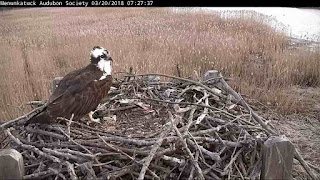 |
| So when will we have eggs? |
I found this information which may be helpful
A male will land on a female’s back many times without this final contact being made. Studies have shown only 30-40% of attempts are successful. Early copulations stimulate the growth of eggs within the female’s ovary and strengthen the pair bond. The last 3 or 4 days before eggs are laid are the most critical for fertilisation.
In a successful copulation the sperm travel to the female’s oviduct. This is where the various stages of egg development occur. First, the sperm fertilises an egg which has been produced during ovulation and already has a yolk. Then the principal coating of albumin is applied before the outer and inner shell membranes are added. These stages take about 5 hours. Next the calcareous shell forms. The background pigments are laid down. The egg stays within the uterus for about 20 hours and tiny glands excrete the streaks and patterns that result in the darker markings on the shell. Finally the egg is laid! The eggs weigh between 60 and 80g and are about the size of duck eggs. The background colour ranges from off white to pale brown, the mottling is red or dark brown. The first egg is usually the largest. Fascinating stuff!



